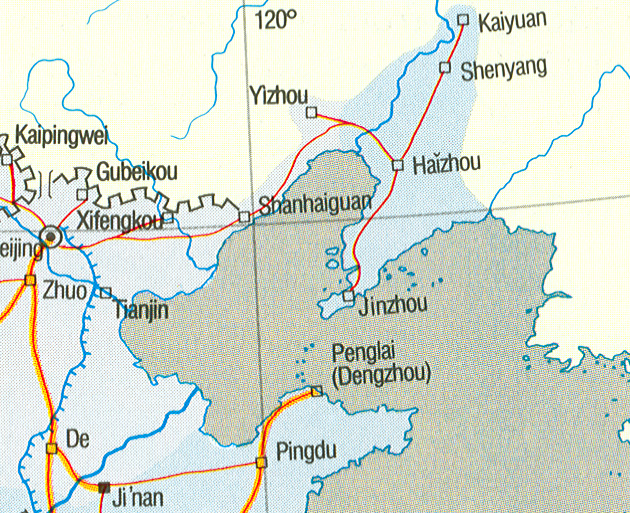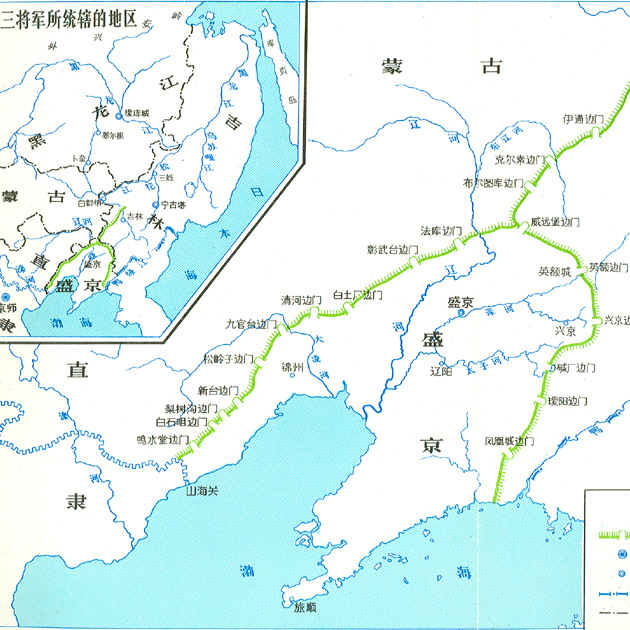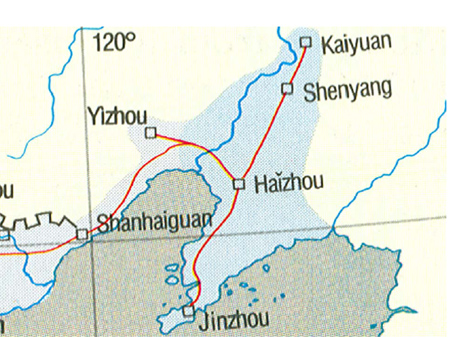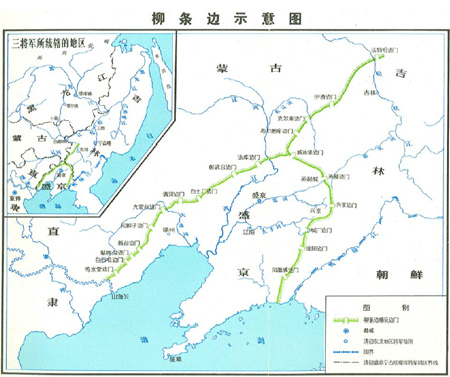|
만주의 어느 지역을 한족(漢族)이 몇 년 동안이나 직접 통치를 했던가?
What part of Manchuria could be ruled, even intermittently, by the Han
Chinese? - The Willow Palisade
홍원탁의
동아시아 역사 강의(1)
일본이나 중국에 의한 역사 왜곡에 흥분하는 사람은 많지만, 정작 연구자가 적고, 역사를 공부하는 사람도 적다. 홍원탁 교수는
동아시아의 고대사를 20년 이상 연구해 왔다. 많은 외국 사이트들이 동아시아의 역사를 일본, 중국의 관점에서만 기술하고 있는 현실에서 한국의
관점에서 동아시아의 역사를 말하는 것이 이 연재의 목적이다. 연재는 영문과 국문번역을 동시에 제공한다. Text in
PDF / 편집자 주
Wontack Hong
Professor, Seoul University
| |
 |
|
|
▲ 2.1. Ming
Boundary
Blunden and Elvin (1998: 94) |
| After the Han Wu-di’s conquest of Old Chosun in 108 BC, the Han Chinese
began to inhabit the fertile Liao River basin called Lioa-dong. It was the only
part of Manchuria that could be put under direct control of the Han Chinese
dynasties, off and on, for about 800 years out of the last three millennia
(1,000 BC-2,000 AD). The Han Chinese settlements were localized almost entirely
on a triangular area in southwestern Manchuria centering on the alluvial basin
of the Liao River and the uplands of the Liao-dong Peninsula. This area came to
be surrounded by a guarded line marked by trees and ditches punctuated with
fortified gatehouses.
As a major way of preserving their identity and their control of mainland
China, the Manchu Qing rulers tried to maintain their homeland as a base
separate from the Han Chinese life and culture. In order to prevent Chinese
immigration from the Liao River basin northward, northern and eastern Manchuria
were closed to Chinese immigration in 1668. A long ditch with an embankment,
repeatedly repaired and expanded, was built across southeastern Manchuria during
the early days of the Qing dynasty (1616-1912). It ran from the Great Wall at
Shanhai-guan, crossed the Liao River to the north of Mukden, and then returned
to the coast near the Korean border down at the Yalu. It marked the boundary of
the pale beyond which the Han Chinese should not expand, the statutory limit of
Chinese settlement.1
| |
 |
|
|
▲ 2.2. Qing Willow
Palisade
(Qingdai Liu-tiao-bian 淸代柳條邊 楊樹森, 遼寧省: 人民出版社,
1978) |
| The big ditch several
hundred miles long and lined with willows is known as the Willow Palisade
(Liu-tiao Bian). The Qing pale surrounded by the Willow Palisade is a little bit
larger than the Ming pale surrounded by the defensive wall (Bian Qiang),
constructed by the Ming during 1437-42 and 1479-81, that was to defend the
Liao-dong area from the intrusion of the Mongol-Xianbei and the Ruzhen.2 It had delineated the Ming borderline in
Manchuria.
The Inner Willow Palisade extending from Shanhai-guan to the mouth of the
Yalu River was intended to keep Han Chinese out of north and east Manchuria, and
the Outer Willow Palisade connecting the Liao River (at the north of Mukden) and
the Song-hua River (at the north of Jilin) was to keep the Mongolic Xianbei out
of Manchuria. Manchu and Mongol bannermen were stationed at twenty outposts
(karun) to patrol its perimeter. The Manchus tried to close their homeland to
Chinese immigration and maintain Manchuria as a hunting land outside the Chinese
agricultural economy.3 Most of Manchuria, with
its hunting lands, forests, and streams, was thus preserved for the tribal
Manchu peoples for a long while.
If we look back over the past three millennia (1000 BC-2000 AD), we see
that the Han Chinese were able to occupy the Liao-dong area for less than 840
years: at most 328 years during the Han dynasties (206 BC.-220 AD) after Wu-di’s
conquest of Old Chosun in 108 BC; 45 years during the Cao Cao’s Wei dynasty
(220-265); less than 51 years during the Western Jin dynasty (265-316); 89 years
during the Tang dynasty (618-907) after 668 until the An Lu-shan Rebellion
(755-57); 276 years during the Ming dynasty (1368-1644); and 51 years under the
People’s Republic of China (1949-2000).4
Bibliography
1 See Elliott
(2001: 50), Fairbank, Reischauer and Craig (1973: 223) and Fairbank (1992:
148).
2 See Kim (2004:
598-601).
3 The Manchu Qing
rulers mobilized the Liao-dong Han Chinese, in the form of Chinese Bannermen,
for their conquest of the Ming dynasty. When they finished conquering the entire
mainland of China, the Qing rulers reclassified many of the original Chinese
Bannermen as honorary Manchus, and made the Altaicized Chinese of Laio-dong as
the official language, called Mandarin, for the entire Han Chinese, though they
themselves continued to speak the Manchu language (see Crossley, 1999, p. 56 and
Janhunen, 1996, pp. 163-7).
4 During the 364 year
period after the beginning of the era of Five Barbarians and Sixteen States
(304-439) until the fall of Koguryeo in 668, Liao-dong had been occupied briefly
by the Xianbei (Former Yan, 349-370) and then for a long time by Koguryeo.
Liao-dong had subsequently been occupied by such “barbarian dynasties” as Parhae
(after the An Lu-shan rebellion in 757 until 926) for 169 years; Qidan Laio
(916-1125) for 209 years; Ruzhen Jin (1115-1234) for 119 years; Mongol Yuan
(1206-1368) for 162 years; and Manchu Qing (1616-1912) for 296 years until at
last it was taken over by the modern (People’s) Republic of China.
©2005 Wontack Hong
All
rights reserved.
East Asian History: A Korean Perspective Vol. 1. No. 1. 2004. 12.
25.
만주의 어느 지역을 한족(漢族)들이 도대체 몇 년 동안이나 직접 통치를 했던가?
한 무제(漢武帝)가 기원 전 108년에 고조선을 정복하고 난 후, 한족(漢族)들은 요동(遼東)이라 불리는 비옥한 요하(遼河) 유역에 이주해
와서 정착하기 시작했다. 지난 3000여 년의 기간 중 (BC 1,000-AD 2,000) 800여 년 내외에 걸쳐서 간헐적으로나마 한족 왕조가
직접적으로 통치할 수 있었던 지역은 만주의 단지 일부분에 불과했다. 한족들이 정착했던 지역은 대부분 요하 유역의 충적지대와 요동반도의 고지대를
중심으로 하는 만주 서남부의 삼각형 모양의 지역에 국한되었었다. 이 지역은 도랑을 파고 제방을 쌓아 만든 장벽으로 둘러싸이게 되었고, 일정한
간격을 두고 요새화 된 관문들도 설치되었다.
| |
 |
|
|
▲ 2.1. Ming
Boundary
Blunden and Elvin (1998: 94) |
| 만주족의 청조(淸朝, 1616-1912)는 중국 본토를
지배하는 동시에 그들의 정체성을 보존하기 위한 주요 정책중의 하나로서, 그들의 본고장을 한족의 생활과 문화로부터 격리된 기지로 만들어
유지시키고자 노력하였다. 한족들이 요하 유역을 벗어나 만주 여타 지역으로 진입하는 것을 막기 위하여, 1668년에는 북만주와 동만주에의 한족의
이주가 법으로 금지되었다.
청조 초기에 만주의 서남지역을 가로질러 도랑을 파고 제방을 쌓기 시작하면서 계속해서 수리를 하고 확장을 했다. 이 도랑과 제방은
산해관(山海關)에서 시작하여 심양(瀋陽) 북쪽의 요하를 건넌 다음 남쪽으로 방향을 틀어 한반도와 경계를 이루는 압록강 변에 이르렀다. 도랑과
제방으로 이루어진 이 방책은 한족의 거주가 허용된 만주지역의 한계를 표시한 것이다
도랑을 파고 제방에 버드나무를 심어 놓은 장벽이 수백 마일에 이르렀는데 이를 유조변(柳條邊)이라고 불렀다. 청조 때 유조변으로 둘러싸인
지역은 1437-42년 사이와 1479-81년 사이에 축조된 명조(明朝)의 방어벽(邊墻)으로 둘러싸인 지역보다 약간 넓었다. 명조의 방어벽은
몽골-선비(鮮卑)족과 여진(女眞)족의 침입으로부터 한족의 거주지역을 방어하기 위해 세워진 것이었다 이 방어벽은 만주지역에서의 명나라의 국경선을
획정했었다
| |
 |
|
|
▲ 2.2. Qing Willow
Palisade
(Qingdai Liu-tiao-bian 淸代柳條邊 楊樹森, 遼寧省: 人民出版社,
1978) |
| 산해관으로부터 시작하여 압록강 어귀에 이르는
내유조변(內柳條邊, 老邊)은 북부 만주와 동부 만주로 한족들이 진입하지 못하게 하기 위해 만들어진 것이며, 심양 북쪽의 요하와 길림(吉林)
북쪽의 송화강과 연결된 외유조변(外柳條邊, 新邊)은 몽골-선비족들이 만주 지역으로 넘어 들어오지 못하도록 막기 위해 만들어진 것이었다. 일정한
간격을 두고 20여 개의 초소(카룬)들을 설치한 다음, 만주 팔기 (八旗)와 몽골 팔기를 배치하여 유조변을 순찰토록 하였다. 만주족은 그들의
본고장에 한족들이 이주해 오는 것을 원천적으로 금지하고, 만주 땅 대부분을 한족의 농업경제에서 격리된, 자신들만의 활 쏘며 사냥을 할 수 있는
터전으로 존속시키고자 하였다. 강, 산림, 사냥터들로 이루어진 대부분의 만주 지역은 오랫동안 만주족을 위하여 이처럼 보존이 되었던 것이다
청나라의 통치자들은 명나라를 정복하기 위하여 요동의 한족들 상당수를 한인팔기 (漢人八旗)의 형태로 동원하였다. 전 중국대륙을 정복하고 난
후, 청나라 통치자들은 많은 수의 한인팔기를 재분류하여 만주족과 동일하게 대접해 주었다. 그들 자신은 계속 만주어를 사용하면서, 정복된
한족들에게는 상당히 알타이어화된 요동의 중국어를 관화(官話)로 정하여 사용토록 하였다. 요동출신 한인팔기들이 사용했던 중국어가 만주족 지배층의
귀에 친근했기 때문이었다.
지난 3천 년간(BC 1,000–AD 2,000)을 돌아보면, 요동은 겨우 840년이 채 안 되는 기간 동안만 한족들에 의해 직접 통치될
수 있었음을 알 수 있다. 즉, BC 108년에 무제(武帝)가 고조선을 정복한 이후의 한대 328년의 기간(108 BC-220 AD),
조조(曹操) 위(魏, 220-265)의 45년간, 그 뒤를 이른 서진(西晉, 265-316)의 51년간, 당(唐, 618-907)이 고구려를
정복한 668년부터 안록산의 난(755-57)이 일어날 때까지의 89년간, 명(1368-1644)나라 276년간, 그리고 중화인민공화국 수립
이후의 51년(1949-2000) 간이 한족이 만주를 직접통치를 할 수 있었던 기간들의 상한을 이루는 것이다.
동아시아 역사 강의 1-1 (2004. 12. 25)
정리: 강현사 박사
ⓒ 2004 by Wontack Hong (업코리아 2004-12-15)
|